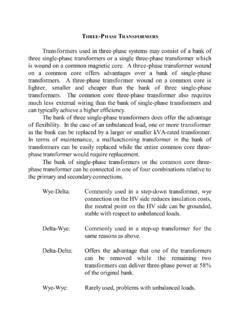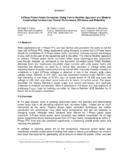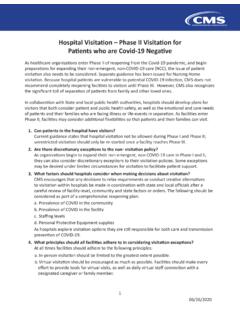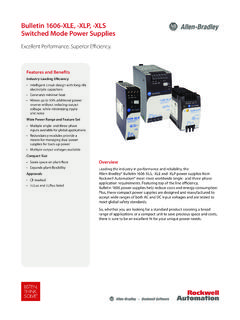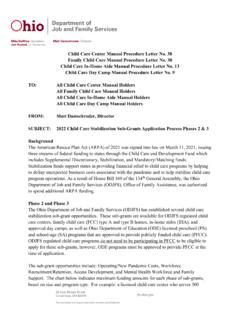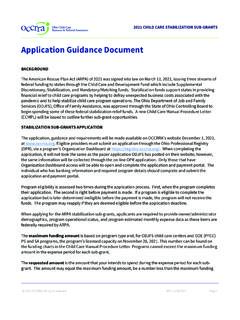Transcription of Feasibility Analysis: Starting a Food Bank System
1 Feasibility Analysis: Starting a Food Bank System A ToolKit from The Global FoodBanking Network Feasibility Analysis: Starting a Food Bank System Food banks change lives and change communities by reducing hunger and malnutrition, by creating jobs, by empowering individuals and enhancing their economic status, and by building the wealth of their communities. Deciding to undertake the establishment of a food banking System involves several phases : 1. Assessment Phase 2. Planning Phase 3. Capitalization Phase 4. Implementation Phase 5. Adjustment Phase In most situations, the process could take from 3 to 9 months before the project has advanced to the point that The Global FoodBanking Network (GFN) can add value. It will likely take another 6 to 12 months, or more, beyond that for a food bank to become operational.
2 The following defines the key activities and objectives of the five phases : 1. Assessment Phase (See Appendix 1 - Environmental Assessments) This phase involves a serious review of the environmental issues related to the establishment and ongoing operation of the food bank System . During this phase, the parties involved will look in depth at defining the need (who is hungry and why; where they are in the country; what are the special issues that affect serving them, etc.). There will also be an in depth study of all existing feeding programs, whether operated by government, the private sector, or civil society. Evaluating the results of the need analysis against the current services analysis will provide valuable guidance as to the gaps in service and will help determine the priorities for the potential food bank s program base.
3 There must also be an assessment of the resources base in terms of food, funds, and volunteers. Finally, the parties working to assess the Feasibility of a food banking System must analyze the legal and regulatory environment in which the food bank will operate. This would include a review of the existing laws and regulations relative to food safety matters, transportation issues, solicitation and distribution of in-kind resources, liability protection for companies making good-faith product donations, tax incentives or disincentives, etc. It is critical that the food bank be appropriately structured, governed, and managed in order to promote full transparency and trustworthiness. Modest expenses are likely to be incurred at this exploratory phase. It will be important to define a budget and identify one or several lead sponsors to finance this initial phase.
4 2. Planning Phase Assuming that the Assessment Phase leads to a decision to move forward with establishing a food bank System , it is critical to establish a planning process with the serious engagement of a broad cross-section of the potential stakeholders in the food bank System . Building a Planning Forum with committed representation from government, the private sector, and civil society is key to ensuring both the diversity of perspective and the connection to resources that will be needed for a fully transparent and responsive food bank operation. Typical participants would include high-level governmental agency heads, major food industry leaders, financial leaders, community group leaders such as Lions Club, Rotary, etc., relevant religious coalitions, United Way, Red Cross/Crescent, etc.
5 Ideally, persons from influential and successful ancillary businesses (IT, logistics, nutrition, health care, transportation, real estate, law firms, accounting, academia, etc.) should also be included as their expertise and spheres of influence can be very beneficial. The work of this Planning Forum should be guided by a Core Team that provides leadership, sets the tone and values of the project, and undertakes the responsibility for moving the project forward in a timely and effective manner. GFN can engage with the Planning Forum and the Core Team in a consulting capacity to help ensure that the process appropriately considers all issues relevant to the Feasibility assessment. If necessary in the earlier stages of the process, GFN may provide more direct facilitation services, helping to build the Forum and the Core Team, with the understanding that its role will revert more to subject matter consultancy as the Forum and Core Team assume greater local management and ownership.
6 There should be a group dedicated to underwriting the expenses of this planning phase. There will be costs associated with gathering the Planning Forum and the Core Team (meeting rooms, meals, etc.) and additional costs for collecting and mining this data. In most countries fees are imposed to register a business, create a name, acquire appropriate licensing, etc. A budget for in-country expenses and a funding plan need to be established by and in support of the group charged with conducting the assessments and planning activities. The end products of this phase include a Business Plan and a Resource Development Plan. The Business Plan will define the structure, governance, management, operations, and administration of the food bank System . It will include the necessary assumptions and decisions regarding staffing requirements, facility and fleet requirements, operating procedures, logistics demands, service delivery procedures, communications and media relations plans, and community outreach and partnership development plans.
7 It will also include ongoing fund raising plans to ensure sustainability and appropriate growth and expansion of services. Most importantly, the plan should define the goals and objectives of the food bank s scope and scale of service: Will it serve the hungry directly or through other NGOs (or both)? Will it attempt to provide 100% of a beneficiary agency s food needs or some smaller amount? Will it try to reach all of the hungry people in the country / community or will it target certain segments of the needy population? Will it provide only non-perishable, packaged foods or will it also provide refrigerated and frozen foods and fresh produce? Will it provide only food or will it also handle non-food grocery products (cleaning supplies, diapers, personal care items, food service items, etc.)
8 ? Will it handle only food and grocery products or will it also handle other items such as clothing, furniture, household goods, How will it define its target distribution activity and measure against those targets? 3. Capitalization Phase Once all of the planning is complete and the food bank is ready to move from concept to reality, the project moves into the Capitalization Phase. In this phase, the appropriate representatives of the project solicit identified funding sources to generate the financial resources necessary to capitalize the start-up of the food bank System . The target funding levels should be defined to include: all capital costs (facility, equipment, fleet, office furniture and equipment, etc.) first year operating costs (occupancy, staff costs, logistics costs, insurance, administrative see attached Sample Food Bank Operating and Capital Budget) potentially, food purchases (A newly established food bank may need to supplement its inventory to be fully ready to serve its beneficiary agencies.)
9 The volume of purchases ultimately should reduce as the food bank evolves its food donation partnerships.) 4. Implementation Phase Having built a viable Business Plan and secured the necessary capitalization, it is time to launch operations. The Business Plan should include a definition of the launch process, including facility and fleet preparations, staff hiring and training, volunteer program definition, public relations and media engagement, initial procedures for service delivery and product donor engagement, etc. It is important that serious consideration be given to the selection of staff. Presuming that in the Planning Phase the characteristics and skill sets of key management positions ( CEO/Managing Director, Operations Directors, Development Directors, etc.
10 Were defined, care must now be exercised to ensure that in the hiring process due diligence is performed to qualify and select the best possible candidates for these positions to ensure successful implementation and stability. It is likewise important that that the Board of Directors be constructed with similar due diligence. Certain specific knowledge and skill sets are essential to the efficient and effective work of the Board, and Directors should be chosen based on these criteria rather than simply on perceived name recognition or networking capability. It is critical that all aspects of operations be subjected to close oversight and frequent evaluation to quickly identify problems and concerns that evolve so they can be resolved expeditiously. It should be expected that various aspects of the plan will not perform as anticipated and will require attention.

